Nizoral dosages: 200 mg
Nizoral packs: 30 pills, 60 pills, 90 pills, 120 pills, 180 pills, 270 pills, 360 pills
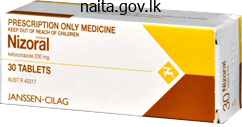
Best buy for nizoral
The frequent iliac, external iliac, or inner iliac (hypogastric) vessels are selectively ligated in accordance with the kind of hemipelvectomy to be carried out. Approach Exposure of the pubis, bladder neck, and urethra permits sectioning of the symphysis pubis. The iliac wing, sacroiliac joint, or sacrum is then exposed and divided to complete the amputation. Division of the lumbosacral plexus on the degree of the sacrum or pelvis is achieved on the identical time. A fasciocutaneous or a myocutaneous flap (involving the gluteus maximus for posterior flaps or the anterior compartment of the thigh for anterior flaps) is then completed. Flexion and adduction and abduction of the hip then permits the surgeon to divide the muscles and ligaments of the pelvic flooring and full the amputation. The posterior flap of the hemipelvectomy includes both the subcutaneous flap over the gluteus maximus or, if a modified posterior flap hemipelvectomy is performed, the above as nicely as the underlying gluteus maximus muscle. The peritoneum is then mirrored off the tumor mass and the retroperitoneal space is developed. The iliac arteries or hypogastric vessels are ligated and transected, the psoas muscle and the femoral nerve are transected, and the belly wall is launched from the iliac crest from the symphysis pubis to the posterior superior iliac spine. All constructions are transected or mobilized anteriorly earlier than proceeding to the subsequent steps. The posterior gluteal incision is carried out with the affected person in a semilateral place in contrast to the standard lateral place regularly utilized by other authors. The retroperitoneal house is well entered by detaching the belly wall musculature from above the ilioinguinal ligament and off the iliac crest. The peritoneum is then reflected off the tumor mass, and the retroperitoneal space is developed. It is crucial to determine all the vascular buildings initially to forestall any mistakes in ligation. A modified hemipelvectomy is an amputation preserving a portion of the wing of the ilium and the underlying gluteus maximus muscle and its major pedicle the inferior gluteal vessels. Therefore, the hypogastric artery is ligated at its takeoff from the widespread iliac artery. This incision extends from the symphysis pubis all the way down to the ischium alongside the inferior pubic ramus. The ischiorectal area is exposed alongside the inferior pubic ramus to the symphysis pubis. The bladder is retracted with a malleable retractor, and an extra small malleable retractor is placed beneath the symphysis pubis notch to defend the urethra. For massive tumors of the pelvic flooring the urethra could also be across the pseudocapsule of the tumor. Therefore, nice care should be taken not to enter the tumor or the pericapsular buildings of the prostate. A basic hemipelvectomy consists of a disarticulation of the sacroiliac joint, due to this fact requiring all the abdominal muscular tissues to be launched as much as the paraspinal muscle tissue. The iliolumbar ligament is an efficient surgical landmark: it inserts onto the ilium posteriorly simply above the superior facet of the sacroiliac joint. The belly wall musculature is released from the crest of the ilium with a 1�2 cm cuff of muscle remaining along the ilium. The psoas muscle has a tendency to bleed postoperatively and will subsequently be oversewn. Depending on the type of hemipelvectomy to be performed (classical or modified), the level of the abdominal wall musculature launch and the level of the posterior osteotomy will vary. The final steps of the amputation contain the discharge of the sacroiliac joint and the remaining pelvic sling muscle tissue attaching to the ilium and pelvic ground. Gross specimen following hemipelvectomy for a quantity of recurrences of metastatic renal cell carcinoma.
Syndromes
- Laxative
- Weakened immune system -- for example, if you have AIDS or are taking medication after a transplant
- Fainting or feeling light-headed
- Collapsed lung
- Tube through the nose into the stomach to empty the stomach (gastric lavage)
- Partial or complete loss of wrist or hand movement
- Use tampons
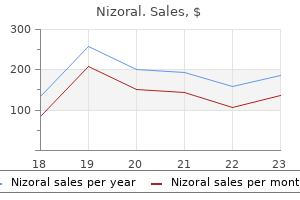
Cheap nizoral 200mg free shipping
This may be due to a big tear or detachment of the dorsal or volar radioulnar ligaments. A visual carpal supination deformity with ulnar prominence that might be passively corrected by a dorsally applied pressure to the pisiform signifies an ulnar extrinsic ligament tear. The examiner must therefore consider all the generally injured buildings on the ulnar side of the wrist. This would trigger tenderness over the lunatotriquetral interval with a constructive shuck take a look at (painful click on as the lunate and triquetrum slide abnormally). An audible clunk and visible subluxation of the carpus that occur with energetic ulnar deviation counsel that a midcarpal instability is present. Crepitus and ache over the pisotriquetral joint on the shear test may point out pisotriquetral arthritis. The other soft tissue constructions around the ulnar wrist must be examined, together with the ulnar nerve, the dorsal ulnar sensory nerve department, and the ulnar artery. Grip strength measurements utilizing a Jamar dynamometer, while subjective, are helpful in quantitating patient effort and as a parameter to observe therapeutic progress. This will allow evaluation for fracture, ligament instability resulting in carpal malalignment, and ulnar variance. After immobilization, a remedy program involving rangeof-motion workout routines and gradual strengthening is initiated. If the styloid remains displaced, then open discount and inner fixation is required. The algorithm for the treatment of degenerative type 2 tears proceeds from arthroscopy to ulnar-shortening osteotomy (see Chaps. Preoperative Planning All bodily examination findings and radiographic examine outcomes have to be reviewed. Examination underneath anesthesia is carried out, including the checks mentioned earlier, before positioning within the arthroscopy tower. The particular therapy for each traumatic class 1 lesion is decided by the kind of tear found arthroscopically. Arthroscopic therapy has become more and more the strategy of choice for lots of traumatic lesions. D�bride the perimeters of the tear and undersurface scarring with a shaver to create cellular edges with contemporary areas for healing. Open the sixth extensor compartment radially for 1 cm and retract the extensor carpi ulnaris ulnarly, providing access to its subsheath. The suture is tied either beneath the skin over the dorsal wrist capsule (preferred) or out of the skin over a bolster. I truly have not found a significant difference between use of a short-arm splint and use of a long-arm or sugartong splint in regard to healing and consequence. Unlike a central tear, fibrous tissue and incomplete healing obscure the precise tear. Base the method of fixation (longitudinal Kirschner wire, screw, bone anchor, or pressure band) on fragment size and surgeon consolation. The wires should exit the radius on its radial border, just volar to the first extensor compartment. An incision is made over the exiting Kirschner wire to retract and defend the radial sensory nerve and the tendons of the primary extensor compartment. Such an isolated tear can be d�brided or repaired based on the diploma of instability. Burring of the attachment website along the sigmoid notch of the radius to bleeding bone is important to introduce additional vascularity and promote wound therapeutic. Range-of-motion workout routines are then progressed, using a removable splint for protection initially. D�bridement of an isolated radial tear not associated with joint instability, similar to that for 1A lesions, yields wonderful results. The microvasculature of the triangular fibrocartilage complicated: its scientific significance. Accuracy of direct magnetic resonance arthrography in the diagnosis of triangular fibrocartilage advanced tears of the wrist. Peripheral tears of the triangular fibrocartilage advanced trigger distal radioulnar joint instability after distal radial fracture. Ulnar shortening combined with arthroscopic repairs within the delayed administration of triangular fibrocartilage advanced tears.
Purchase nizoral online
The former two surgeons have been the first within the United States to develop endoprosthetic replacements for tumor sufferers. Starting with a only a few extremely selected patients with extremity osteosarcoma, limb-sparing surgery now is a treatment option for most bone and gentle tissue sarcomas, not solely of the extremities, but of the pelvis and shoulder girdles as properly. Today, over 90% to 95% of tumor sufferers may be anticipated to undergo profitable limb-sparing procedures when handled at a major middle specializing in musculoskeletal oncology. This dramatic alteration in patient care required important advances alongside many fronts, together with the next: Better understanding of tumor development and metastasis Determination of appropriate surgical margins Use of effective induction (neoadjuvant or preoperative) chemotherapy Development of improved approaches, preserving soft tissue vascularity Deeper understanding of skeletal biomechanics Advanced materials engineering and manufacturing techniques Development of inherently secure modular prostheses. The chapters in this section define in particular element many of the surgical approaches and strategies of oncologic resection and reconstruction currently used by leaders in the area of orthopaedic oncology. A successful limb-sparing surgery consists of three interdependent stages performed in sequence: 1. History of Endoprosthetic Reconstruction Austin Moore and Harold Bohlman, in 1940, have been the first to publish an instance of endoprosthetic reconstruction for a bone tumor, consisting of a custom-designed Vitallium proximal femur used for a patient with a large cell tumor of bone. This led to the development of the idea of induction (initially referred to as preoperative or neoadjuvant) chemotherapy, in which the newly confirmed medicine doxorubicin and methotrexate were administered during the interval between prognosis and delivery of the manufactured custom implant. Induction chemotherapy has since been adopted in the management of an increasingly large variety of other cancers. As the demand for endoprosthetic reconstruction grew, all kinds of customized implants became obtainable from a selection of orthopaedic manufacturers. However, improved materials and manufacturing methods developed for the worthwhile and ever-expanding market for total joint replacements finally had been applied to these "mega" prostheses. The adoption of the rotating hinge for implants around the knee and bipolar heads for the hip followed successful use of these designs for complete joint alternative. While these advances significantly improved the performance of custom implants, issues with the time required for manufacturing and the lack of flexibility at the time of implantation hampered the widespread acceptance of custom endoprosthetic reconstruction. Although modularity elevated the complexity of the mechanical construct and carried a danger of failure associated with the sum of all of the components, these potential problems were simply outweighed by important benefits. Custom segmental prosthesis used during Eighties previous to the development of the Modular Replacement System by Howmedica, Inc. Standardization of elements permits the implant producer to enhance the level of high quality management tremendously, while reducing the general cost of manufacturing through economies of scale. Modular systems scale back general inventory and time to supply whereas offering a extensive selection of prosthetic shapes and sizes. Modular systems permit hospitals to keep an on-site inventory that has allowed these systems to be obtainable immediately as a backup possibility for chosen non-oncologic patients, corresponding to these present process difficult joint revision surgery or patients with important periarticular fractures. This system featured intramedullary cementless press-fit stems supported by exterior flanges and cortical transfixation screws, whereas the knee mechanism con sisted of a simple hinge design. Although the system actually was modular, in medical practice the long-term outcomes have been disappointing. Significant issues encountered with this gadget included aseptic stem loosening (osteolysis), substantial stress shielding with bone resorption, screw fracture and migration, and a polyethylene failure fee higher than 40% for the knee mechanism. This prosthesis, initially designed for the treatment of infected failed total hip replacements, was modified to allow for reconstruction of the hip following resection of the pelvis. The distinctive feature of this method is the saddle itself, which is a U-shaped part that straddles the ilium, allowing motion in flexion�extension, and abduction�adduction within the anteroposterior and lateral planes in opposition to the bone. The saddle is attached with a rotating polyethylene lined ring, rising the degree of freedom and permitting for hip rotation. These are attached to a collection of interchangeable modular our bodies that, in flip, connect with a standard cemented femoral stem. Examples of failed, retrieved, customized endoprosthetic implants used during the Eighties. The commonest mode of mechanical failure was stem breakage or bending, sometimes due to small stem diameter or from stress risers attributable to the sharp transition from the prosthetic physique to the stem. Intraoperative assembly of the prosthesis requires impaction of locking Morse tapers to connect the stem, body segments, and joint modules.
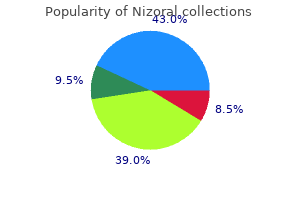
Purchase nizoral 200mg fast delivery
These may be minimized by fastidious surgical method, aggressive rehabilitation as needed, and diligent followup in the early postoperative interval. Intracarpal soft-tissue lesions associated with an intra-articular fracture of the distal end of the radius. Chapter 4 Open Reduction and Internal Fixation of Diaphyseal Forearm Fractures Michael R. Surgical reconstruction of diaphyseal forearm fractures requires precise realignment of both radius and ulna to decrease complications and maximize operate. Ingenious surgical approaches have been described that enable the surgeon to follow defined internervous planes to the bones for inside fixation. The design of the forearm permits near 180-degree rotation combining with considerable elbow flexion�extension and wrist circumduction. To achieve this, the ulna is enlarged proximally, making it a principal bone of the elbow, and is smaller distally, while the reverse is true for the radius, with the enlarged radius being the first articulation with the carpus. The end result for the diaphysis of each bone is that the proximal ulna is metaphyseal for about 25% to 30% of its length but distally less than 10%, with the reverse holding true for the radius. Implant design has taken these variations into consideration, with many complete techniques available for metaphyseal distal radius and proximal ulna fractures. The importance of sustaining the radial and ulnar heads has only just lately been understood. This permits the ulnar head to transfer out of the means in which of the rotating radius distally. Schemitsch and Richards22 quantified the significance of the distal of the 2 bows within the radius. Restoration of this bow is the single most necessary step in reconstruction of the forearm after diaphyseal fracture. To decide whether the bow has been restored after osteosynthesis, draw a line from the biceps tuberosity to the sigmoid notch. At the apex of this bow on the convex facet is the insertion of the pronator teres. The radius rotates around a longitudinal axis that passes through the center of the radial head on the proximal radioulnar joint and thru the middle of the ulnar head distally. Muscles and Ligaments the forearm is criss-crossed with longitudinal, indirect, and transversely directed musculotendinous models. These muscle tissue are in layers, with longitudinal muscle tissue more superficial and crossing muscular tissues deeper. It proceeds straight down the forearm along the ulna border and inserts into the pisiform. Crossing the forearm in its deepest elements are a series of obliquely oriented muscle tissue. The supinator plays a role in both the anterior and posterior approaches to the radius. It has two heads of origin and possibly may be considered two muscles, as a end result of the fibers of every head traverse in numerous instructions. The pronator teres originates primarily from the medial supracondylar ridge, arches obliquely across the ulnar artery and median nerve, and inserts into the apex of the larger bow of the radius. It should be lifted from probably the most radial facet of the radius within the anterior strategy. It have to be lifted from the radial border in an approach to the radius and the ulna border in an strategy to the ulna. In a posterior approach to the radius, the abductor pollicis longus muscle drapes throughout the radius simply distal to its midpoint. The interval between the brachioradialis and flexor carpi radialis is entered, and the radial artery is retracted laterally. The supinator, pronator teres, flexor pollicis longus, and flexor digitorum superficialis could be seen. Each nerve enters the forearm from the arm in a predictable place, and every offers off key branches that must be protected. The posterior interosseous branch leaves the principle nerve simply distal to the elbow and passes by way of the supinator muscle, between its two heads, to enter the dorsal or extensor compartment of the forearm. The course of the ulnar nerve is represented by a line drawn from the medial epicondyle to the pisiform. The median nerve enters the forearm between the brachial artery and the tendon of the biceps brachii.
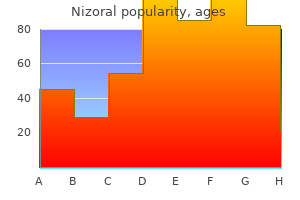
200 mg nizoral amex
Key exams and maneuvers particularly evaluating the scapholunate and lunotriquetral ligaments are as follows: Grip energy and pain: Diminished grip strength correlates with wrist pathology. The presence of pain at the central aspect of the wrist with attempted grip has additionally been associated with scapholunate ligament pathology. Scaphoid ballottement take a look at: Pain and increased anteroposterior laxity are extremely suggestive of scapholunate instability. Triquetrum ballottement take a look at: Pain and elevated anteroposterior laxity are extremely suggestive of lunotriquetral instability. If scapholunate pathology is suspected, a bilateral pronated grip anteroposterior (Mayo Clinic) view ought to be obtained for comparison to the contralateral aspect. Arthroscopic options embrace easy d�bridement, d�bridement with thermal shrinkage, and d�bridement (with or with out shrinkage) with percutaneous pinning. Static instability and severe dynamic instability are indications for open surgery. Surgical options embrace open restore or augmentation (especially of acute or subacute injuries), capsulodesis, and tenodesis. The focus of this chapter is on arthroscopic procedures described for administration of dynamic scapholunate or lunotriquetral instability. Newer arthroscopic alternatives advocated for administration of more superior pathology are additionally described. Thermal shrinkage is carried out in an try and increase stability and enhance long-term outcome in comparison with easy d�bridement. This leads to denaturation (uncoiling) of the collagen triple helix with discount in total ligament size. Use of this gadget is contraindicated in patients with pacemakers or other implantable digital gadgets. In most instances, nonetheless, a call on the type of process to be performed is made intraoperatively based on the arthroscopic findings and associated pathology. Consideration should subsequently be given to have the next obtainable: radiofrequency probes, mini C-arm, drills, Kirschner wires of various widths, and headless compression screws. Positioning the affected person is placed in the supine position with the extremity on a hand table. Any attainable donor web site for ligament reconstruction or augmentation must also be prepared and draped in a sterile trend. The arthroscope monitor is positioned on the other aspect of the hand table from the surgeon. Approach Arthroscopic evaluation and administration of scapholunate and lunotriquetral accidents can typically be carried out via normal dorsal wrist portals (3�4, 4�5, 6R, midcarpal). If use of fluoroscopy is anticipated, the C-arm is positioned adjacent to the head of the operating desk. In this situation, the arthroscope is transferred to the 6R portal and directed radially. The scapholunate joint is depicted here but the classification can additionally be relevant to the lunotriquetral joint. Grade I: Attenuation of the scapholunate interosseous ligament as visualized in the radiocarpal joint. The volar radioscapholunate and long radiolunate ligaments (wider) are visualized radially, and the short radiolunate is situated ulnar to the ligament of Testut. Both ligaments should be evaluated in their entirety (dorsal, proximal, and volar portions). The scapholunate joint is visualized radially and the lunotriquetral joint ulnarly. A Watson scaphoid shift check may be performed while visualizing the scapholunate joint. Redundant tissue is then resected to a secure rim with the synovial resector or bipolar radiofrequency probe.
Vitamin A2 (Vitamin A). Nizoral.
- Dosing considerations for Vitamin A.
- Anemia.
- Reducing fetal and early infant death in children born to women with nutrition problems.
- Lung cancer, ovarian cancer, cervical cancer, esophageal cancer, pancreatic cancer, colorectal cancer, gastric cancer, promoting good vision, age-related macular degeneration (AMD), glaucoma, preventing and speeding recovery from infections, improving immune function, skin conditions other than acne, relieving hayfever symptoms, and other conditions.
- How does Vitamin A work?
- Are there safety concerns?
- What is Vitamin A?
- Reducing complications of diseases such as malaria, HIV, measles, and diarrhea in children with vitamin A deficiency.
- Reducing problems during pregnancy and after giving birth in underfed (malnourished) women.
- What other names is Vitamin A known by?
Source: https://www.rxlist.com/script/main/art.asp?articlekey=96926
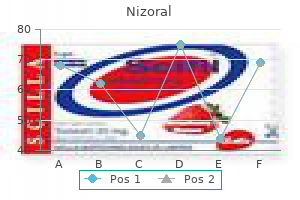
Buy nizoral australia
Finally, these altered relationships create an actual, or obvious, shortening of the lateral column (or border) of the foot relative to the medial column. The shapes of the bones and the laxity of the ligaments of the foot decide the peak of the longitudinal arch. The muscle tissue preserve steadiness, accommodate the foot to uneven terrain, shield the ligaments from unusual stresses, and propel the body forward. The intrinsic muscular tissues are the principal stabilizers of the foot throughout propulsion. Back view reveals valgus alignment of the hindfoot and "too many toes" seen laterally. Medial view exhibits depression of the longitudinal arch and a convex medial border of the foot. The arch increases in height in most kids by way of regular development and growth during the first decade of life. Flexibility (hypermobility) in a versatile flatfoot refers to the motion in the subtalar joint. It is the traditional foot shape seen in nearly all infants and accounts for about two thirds of the 23% of flatfooted adults. It is the traditional contour of a strong and stable foot, not the trigger of disability. A flexible flatfoot with a short Achilles tendon has the identical flexibility within the subtalar joint as a flexible flatfoot, however has limited ankle dorsiflexion owing to contracture of the Achilles tendon. This entity accounts for about one fourth of the 23% of flatfooted adults and often causes ache with callus formation beneath the top of the talus. Rigidity in a inflexible flatfoot refers to the restriction of movement within the subtalar joint. It is normally associated with a tarsal coalition and is, therefore, developmental quite than congenital, just like the versatile flatfoot. A contracted Achilles tendon prevents normal dorsiflexion of the talus in the ankle joint during the late midstance phase of the gait cycle. The dorsiflexion stress is shifted to the subtalar joint complex where, as a function of eversion, the acetabulum pedis dorsiflexes in relation to the talus and in addition in relation to the tibia. The soft tissues underneath the pinnacle of the talus are subjected to extreme direct axial loading and shear stresses. Pain can also be experienced in the sinus tarsi region due to impingement of the beak of the calcaneus with the lateral means of the talus at the extreme vary of eversion. Older kids and adolescents with versatile flatfoot with a short Achilles tendon will often expertise pain, tenderness, and callus formation under the head of the plantarflexed talus within the midfoot or within the sinus tarsi space or at each websites. About 25% of kids and adolescents with a tarsal coalition report activityrelated ache which may be positioned within the sinus tarsi space, alongside the medial hindfoot, or beneath the pinnacle of the talus. Such concerns about future incapacity are primarily based on unsubstantiated claims by generations of health care professionals that flatfoot is a deformity that requires treatment to prevent ache and incapacity. Their interrelationships are essential to bear in mind throughout evaluation of the foot because all of those options change because the baby grows. It is a mixture of deformities that features a valgus deformity of the hindfoot and a supination deformity of the forefoot on the hindfoot. The axis of the subtalar joint is in an indirect aircraft, such that eversion creates valgus, exterior rotation, and dorsiflexion of the so-called acetabulum pedis around the talus. A flexible flatfoot has free and supple subtalar joint movement in the axis of the joint. The longitudinal arch develops spontaneously in most kids through the first decade of life. Flexible flatfoot with a brief Achilles tendon typically causes ache with callus formation under the pinnacle of the talus or ache within the sinus tarsi area. While maintaining subtalar joint neutrality, the ankle is dorsiflexed with the knee first flexed after which extended to assess the tour of the soleus and the gastrocnemius respectively. These two maneuvers take advantage of the windlass motion of the plantar fascia to mobilize the subtalar joint into inversion and create a longitudinal arch.
Purchase nizoral overnight
Two of the polyethylene component failures occurred in the identical affected person; the primary occurred 2. During revision of their prostheses, all sufferers who underwent additional surgery due to a loosened prosthesis were found to have concomitant failure of a polyethylene part. It happens independent of the sort of reconstruction (arthrodesis, allograft, or endoprosthesis). Infections Infections are associated to the local setting at surgical procedure, bacteremias in the quick postoperative interval, size of the surgical procedure, and gentle tissue protection problems. The distinction is mostly as a outcome of changes in surgical method and reconstruction of the delicate tissues. Most different bacterial infections and all of the gram-negative infections are troublesome to remedy and may result in amputation. The key to success is to analyze the failure mode and never do the same reconstruction. Although the literature means that revisions have a 50% failure rate at 5 years, should you analyze the failure mode and proper it, the revision should last more than the original reconstruction. Anteroposterior stability and mediolateral stability are built into the mechanism, which allows full resection of all the knee ligaments, a necessity in all tumor resections. The capability to rotate barely with loading defuses stress on the bone�prosthesis or the bone�cement�prosthesis interfaces, diminishing aseptic loosening and fatigue fracture. Reaming the canal must be accomplished slowly and gently with sharp reamers and frequent irrigation and suction. Although cement restrictors and pressurization of the cement are frequently used, stem insertion is once more done gently and slowly. Patients ought to be properly hydrated and oxygenated before insertion of cemented femoral stems. The overall deep an infection, aseptic loosening, and poly failure rates have been each 5%. Bushing Failures and Pseudomeniscus Formation Bushing failures are heralded by the sudden onset of knee joint ache and a way of instability to the point that ambu latory aids are necessary. Patients with pseudomenisci current with localized pain, lack of full extension, and no effusion. Scar tissue over time and with fixed movement will type a real fibrocartilage kind of scar that takes the shape of a real meniscus. Pseudomeniscus formation occurs incessantly however is symptomatic in just a few sufferers. The symptoms are often delicate, usually presenting as an inner derangement of the knee. The most suggestive signs are a sense of instability, combined with slight valgus instability (more than 5% on a stress test), and with or and not utilizing a small effusion. These symptoms might mimic those of a bushing failure, but with much less instability and a smaller effusion. The treatment is resection of the pseudomeniscus as properly as the pseudocapsule within the hope of stopping a recurrence. Exploration of the reconstruction, resection of the "pseudosynovium" or periprosthetic capsule, and change of the bushings and extensor cease can manage this. If the cemented tibial poly is removed, then at reconstruction a metal-backed tibial component is used. Total knee alternative including a nodular distal femoral part in elderly patients with acute fractures and nonunion. A modular endoprosthetic system for tumor and non-tumor reconstructions: preliminary report. Extramedullary porous coating to forestall diaphyseal osteolysis and features round proximal tibial replacements. The anterior popiteal strategy for popiteal exploration, distal femoral resections, and endoprosthetic reconstruction.
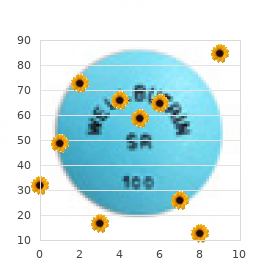
Order 200 mg nizoral otc
Major joints include the large, flat sacroiliac joints, the hip joints, and the pubic symphysis. The hip joint is well located by movement of the extremity; the opposite joints are simply located and recognized by palpation. Other simply palpable bony prominences include the iliac crest, the anterior superior iliac spine, the ischial tuberosity, and the greater trochanter of the femur. These landmarks are important in creating rational pores and skin incisions during the process. Likewise, identification of inside bony landmarks helps localize adjacent buildings. The lumbosacral plexus is discovered by palpating the sacroiliac joint, the sciatic nerve and gluteal vessels are found beneath the sciatic notch, and the urethra is found underneath the arch of the pubic symphysis. Vascular Anatomy Ligation of the proper pelvic vessels is essential to a profitable amputation. As the abdominal aorta and vena cava descend into the pelvis they bifurcate, creating the common iliac arteries and veins. This bifurcation sometimes occurs at L4, with the decrease bifurcation occurring at S1. The left-sided aorta and the iliac and external iliac arteries stay anterior to the major veins throughout the pelvis. The inner iliac artery (hypogastric artery) bifurcates from the posterior floor of the common iliac artery as it travels down towards the sciatic notch. The internal iliac (hypogastric) vessels provide the pelvic flooring, rectum, bladder, and prostate, as nicely as the gluteal muscle tissue. Pathological fracture (distal location) via an especially giant renal cell carcinoma of the left pelvis. Solitary renal cell carcinoma metastasis of the right proximal femur extending into the pelvis. Solitary renal cell carcinoma metastasis is taken into account to be one of the few indications for radical amputation due to metastatic carcinoma. Plain radiograph of the proximal femur showing the intramedullary rod extending from the hip distally with contamination of the complete lateral and aspect of the thigh. Gross specimen after hemipelvectomy displaying an extremely giant chondrosarcoma arising from the proximal femur. Classic hemipelvectomy, during which these branches are divided, has a considerable price of wound problems as a direct result. Pelvic Viscera In addition to the crucial vascular structures, major organs of the gastrointestinal and genitourinary tracts are current and exposed during a hemipelvectomy. The bladder and urethra, and the prostate in male sufferers, are situated above and beneath the pubic symphysis. Placement of a Foley catheter with a large inflated balloon makes these structures easier to palpate during surgery. In addition, the venous plexus surrounding the prostate is often a vital supply of bleeding that may be difficult to management even with good visualization of the organ. The ureters are vulnerable to injury as they cross over the iliac vessels from lateral to medial. In feminine patients the ovaries, fallopian tubes, uterus, cervix, and vagina require identification and protection. Most of the gastrointestinal tract is protected by the peritoneum and is gently retracted out of the operative subject. Of specific concern is the sigmoid colon, which have to be protected during left-sided amputations. The colon and rectum must even be identified and guarded during the division of the sling muscle tissue earlier than completing the amputation. Insertion of a rectal tube earlier than surgery helps to identify both these constructions and to decompress them. Because of the possibility of bacterial contamination from these constructions, preoperative bowel preparation and the usage of acceptable antibiotics are prudent. In addition, patients with extremely giant sarcomas involving multiple compartments of the thigh might require an immediate amputation to avoid tumor fungation, hemorrhage, and secondary an infection. In every case the sort of hemipelvectomy performed is dictated by the anatomic location of the tumor and the expected defect to be created by the resection.
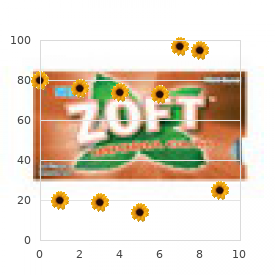
Generic nizoral 200 mg fast delivery
If necessary and curative resection is planned, each buildings may be excised en bloc with the tumor after which may be repaired with a graft. However, when a compound resection (bony pelvis and viscus resection) is anticipated, the patient must be knowledgeable, and surgical assistance and essential tools must be prepared in advance. Combined data, gained from two or more imaging modalities, permit a practical appreciation of the precise anatomic extent. Even when that data is on the market, however, the full extent of a pelvic tumor often is underestimated preoperatively. Review of any imaging research of the pelvis, due to the numerous anatomic particulars, should be performed very methodically. The authors evaluation the constructions from the back (midsacral region) and observe the pelvic girdle to the front (symphysis pubis), as described within the following paragraphs. Nerve involvement, subsequently, is assumed on the premise of the ache sample, physical examination, and the presence of the tumor in shut proximity to a website by which a major nerve or plexus is often located. Clinical evidence of femoral or sciatic nerve dysfunction usually means direct tumor involvement. In most instances the presence and extent of nerve involvement is established solely at the time of surgery. Sacral plexus invasion by tumor has the same significance when it comes to resectability as tumor invasion of the sacrum; bilateral involvement is an indicator of unresectability. Sacrum, Sacral Alae, and Sacroiliac Joint Most sufferers who bear prolonged hemipelvectomy, which necessitates transection of the sacrum through the ipsilateral neural foramina, regain perform of the gastrointestinal and genitourinary tracts. Adding a contralateral compromise of the sacral nerve root will create a severe dysfunction. The tumor may be resected, however the morbidity outweighs the questionable oncologic benefit from surgical procedure. The common iliac vessels are just anterior to the sacral ala, and any cortical breakthrough by a tumor in that site may be anticipated to prolong on to the blood vessels. The main nerves and Sciatic Notch and Nerve the sciatic notch is the site of pelvic osteotomy in resections of the ilium or periacetabular area and in modified hemipelvectomy. The piriformis muscle, which divides the sciatic notch, is a key construction, because the sciatic nerve exits the pelvis beneath it and the superior gluteal artery exits the pelvis above it. The patency of the superior and inferior gluteal arteries, which provide the gluteal vasculature, is established by angiography. Adequate blood supply of the gluteal region is a serious consideration in flap design, and the artery have to be preserved in any pelvic resection, if oncologically feasible. The artery is located just a few millimeters from the periosteum of the sciatic notch roof, and it should be dissected carefully. Ilium the inside facet of the bone is covered by the iliacus muscle, which originates from the iliac crest. The iliacus is "pushed" by a rising bone sarcoma and serves as a major barrier to direct extension of tumor to the anatomic buildings of the pelvis. Wide excision would necessitate resection by way of the contralateral sacral foramina, resulting in an unacceptable practical impairment. The sciatic nerve exits the notch underneath the piriformis muscle, and the superior gluteal vessels exit the notch above it. The iliacus muscle (arrows) is "pushed" by a growing bone sarcoma and serves as a barrier to direct extension of the tumor to the pelvic viscera. High-grade sarcoma of the left ilium "pushing" the iliacus muscle (arrows) towards the midline. Metastatic carcinomas (arrows) to the pelvis tend to invade the masking muscle layer. Extension to Pelvic Viscera Direct involvement of a pelvic viscus by a pelvic girdle tumor is uncommon. Left-sided tumors usually tend to contain a component of the gastrointestinal tract because of its shut proximity to the pelvic girdle at that point. A rectal tube is inserted preoperatively during any pelvic resection to facilitate identification of the rectum throughout dissection.
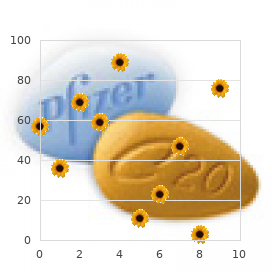
Buy 200 mg nizoral otc
Placing the shoulder and arm in the "salute" place after which tying the tendons helps in acquiring the right tension. Closure and Immobilization the wound is then closed over drainage tubes in multiple layers, and the shoulder is positioned in an abduction shoulder brace, with the shoulder kidnapped 30 levels and internally rotated forty five levels. It is essential to clear the prosthetic stem of all cement after it has been inserted by way of the allograft. A trial discount of the allograft prosthetic composite, marking rotation, is crucial for perform and shoulder stability. When placing a lateral plate to stabilize the allograft prosthetic composite to the host bone, drilling by way of the cement can be difficult. Usually 30 levels of retroversion is marked before internal fixation of the allograft to the host bone to forestall instability from part malposition. It is necessary to angle the screws away from the prosthetic stem when utilizing a dynamic compression plate. Therefore, cerclage wires or unicortical screws are used with a locking plate around the stem. The commonest problem is subluxation of the glenohumeral joint, relying on the quantity of sentimental tissue obtainable for reconstruction. Tendon healing and repair is allowed for about four weeks, after which mild shoulder workout routines are begun. Approximately 6 weeks postoperatively, light active workouts are initiated, but no resistance is applied to the gentle tissue restore for two months. At that point, extra aggressive range-of-motion and muscle workout routines are began to maximize the useful restoration. Serial radiographs are carried out to verify for healing at the allograft�host bone junction. Typically, union at this junction occurs someplace between three months and 12 months postoperatively. If a nonunion develops and 1 year has passed, then autogenous grafting is performed to increase the therapeutic. At the most recent follow-up, 10 of the 11 sufferers have been alive, they usually reported good perform of the upper extremity. The function was not detailed when it comes to range of motion, muscle energy, or joint stability. The authors reported a quantity of complications, together with nonunion at the allograft�host bone junction and wound infections. Jensen and Johnston7 reported on 4 sufferers with an allograft prosthetic composite utilizing the Neer prosthesis and located glorious outcomes. In 2005, Kassab et al8 reported on three sufferers with an allograft prosthetic composite of the humerus. Damron et al2 functionally evaluated shoulder reconstruction and concluded that the osteoarticular allograft procedure had the most effective outcomes if the abductors of the shoulder are preserved. An osteoarticular allograft, which was used in eight patients, had one of the best practical outcomes in their cohort. Other authors reported outcomes with osteoarticular allograft reconstruction after an intra-articular resection. Some of the fractured allografts had been salvaged with an allograft prosthetic composite arthroplasty. Wang et al11 reported osteoarticular allograft fractures in 14 of their 20 patients. In 1999, Getty et al5 reported on sixteen sufferers who had undergone intra-articular resection of the proximal humerus with an osteoarticular allograft reconstruction. Complications reported on this sequence included 4 fractures of the allograft and one an infection. Other issues reported included glenohumeral instability in three sufferers and dislocation of the glenohumeral joint in eight patients.
Real Experiences: Customer Reviews on Nizoral
Larson, 64 years: Both the lunate and the distal row have been drawn away from the scaphoid to higher expose the ligaments. The profundus femoris artery is ligated so that the flap could be raised above the inguinal ligament and the retroperitoneal approach of the hemipelvectomy can proceed.
Gorok, 31 years: Through a dorsal method, the interval between the extensor pollicis brevis and longus (arrow) is developed and the joint is entered. Soft tissue closure is critical to cover and fill the popliteal house to stop wound issues.
Sven, 54 years: The clinician should examine related anomalies, corresponding to spina bifida, spasticity, muscular dystrophy, arthrogryposis, and so forth. Violation of the sheath, the liner, or the blood provide to the tendons by trauma or an infection might lead to dense scar and adhesion formation and can compromise the results after both a primary restore or an attempt at single-stage reconstruction with a tendon graft.
Moff, 25 years: Intraoperative To cut back the danger of postoperative infection, bowel preparation should be performed for all patients. Now the calcaneus is dorsiflexed relative to the tibial axis and what was seen on the pretenotomy radiograph (B).
Hassan, 32 years: Testing for the tenodesis effect (digits passively flex with wrist extension) or compressing the flexor musculature in the forearm should help with prognosis in these situations. The first cut of the osteotomy is performed two thirds of the way by way of the primary metatarsal at the junction of the metaphysis and diaphysis and is oriented perpendicular to the long axis of the primary metatarsal (line 2).
Ballock, 37 years: Our choice, based mostly on outcomes studies carried out at our institution, is tendon repair or reconstruction. Risk elements for fracture instability, lack of discount, and malunion include age over 60 years, more than 20 degrees of dorsal angulation, dorsal metaphyseal comminution, comminution extending to the volar metaphyseal cortex, associated fracture of the ulna, and displaced articular fracture.
Vasco, 26 years: It is affordable to think about nonoperative therapy of an isolated ulna fracture with lower than 10 levels angulation,21 however nonoperative treatment of both-bone forearm fractures has a poor consequence. Partial scapholunate ligament accidents handled with arthroscopic debridement and thermal shrinkage.
10 of 10 - Review by W. Jose
Votes: 128 votes
Total customer reviews: 128
References
- Rose MR, ENMC IBM Working Group. 188th ENMC international workshop: inclusion body myositis, 2-4 december 2011, Naarden, The Netherlands. Neuromuscul Disord. 2013; 23:1044-1055.
- Chen SA, Chiang CE, Yang CJ, et al. Sustained atrial tachycardia in adult patients: electrophysiological characteristics, pharmacological response, possible mechanisms, and effects of radiofrequency ablation. Circulation 1994;90(3):1262-1278.
- Peters, C.A., Woo, R. Intravesical robotically assisted bilateral ureteral reimplantation. J Endourol 2005;19:618-621.
- Harrison DA, Mullaney PB, Mesfer SA, et al. Management of ophthalmic complications of homocystinuria. Ophthalmology 1998;105:1886.
- Kiemeney LA: Hereditary bladder cancer, Scand J Urol Nephrol Suppl 110n115, 2008.
- Khedr EM, Ahmed MA, Fathy N, et al. Therapeutic trial of repetitive transcranial magnetic stimulation after acute ischemic stroke. Neurology 2005;65:466-8.
